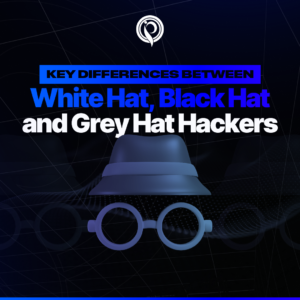
Key Differences Between White Hat, Black Hat, and Grey Hat Hackers
By contributor Lyan Ware
As far as hackers go, they come in various shades, each with distinct motivations and ethical considerations. Understanding the differences between White Hat, Black Hat, and Grey Hat hackers is a small but essential facet of cybersecurity. In this blog post, we’ll explore the fundamental characteristics and roles of each type of hacker.

White Hat Hackers
White Hat hackers, also known as ethical hackers or security researchers, are the defenders of cyberspace. They use their expertise to identify vulnerabilities and weaknesses in computer systems, networks, and applications. Their primary goal is to improve security by exposing weaknesses before malicious actors can exploit them.
White Hats work within the boundaries of the law and have noble intentions. They collaborate with organizations to conduct penetration testing, vulnerability assessments, and security audits. These professionals seek to ensure that systems are well-protected and can withstand potential attacks.
They use their skills to simulate cyberattacks and identify vulnerabilities. Afterwards, they’ll debrief with recommendations for enhancing security measures, which may include patching software, configuring firewalls, and implementing encryption protocols.

Black Hat Hackers
In stark contrast, Black Hat hackers are driven by malicious intent. They engage in unauthorized activities to compromise systems, steal sensitive data, or cause harm. Their actions are illegal and unethical, as they intentionally violate the law and exploit vulnerabilities for personal gain or malicious purposes.
Black Hat hackers are motivated by financial gain, political objectives, or a desire for recognition among the hacking community. They seek to exploit vulnerabilities to steal personal information, financial data, or trade secrets. Their activities can lead to significant financial losses and reputational damage for their victims.
They use a range of techniques, such as phishing, malware distribution, and social engineering, to infiltrate systems and networks. These malfeasant agents operate in secrecy, making it challenging for law enforcement to track and apprehend them.

Grey Hat Hackers
As their name implies, Grey Hat hackers fall somewhere between the ethical spectrum of White Hat and Black Hat hackers. They do not have malicious intent but may engage in activities that are technically illegal or unethical, such as discovering vulnerabilities without permission.
Grey Hat hackers may uncover vulnerabilities in systems and networks without seeking permission from the owners. While their intentions may not be inherently malicious, their actions can cause legal and ethical dilemmas.
Grey Hats expose vulnerabilities publicly to pressure organizations into improving their security practices. While they aim to raise awareness, their actions can lead to unintended consequences, such as exposing sensitive data to unauthorized individuals.
In conclusion, the world of hacking is multifaceted, encompassing individuals with diverse motivations and ethical considerations. White Hat hackers play a pivotal role in enhancing cybersecurity by identifying and addressing vulnerabilities. Black Hat hackers engage in malicious activities for personal gain, causing harm to individuals and organizations. Grey Hat hackers navigate a morally ambiguous path, uncovering vulnerabilities without clear ethical boundaries. As the field of cybersecurity expands, hopefully these terms will become more commonplace, reflecting a growth in cybersecurity best practices and awareness.
The Growing Field of Cybersecurity: Career Opportunities and Skills Needed
Exploring the World of Ethical Hacking and Certified Ethical Hacker (CEH) Certification
Benefits of The CompTIA Security+ Certification

































Leave a Reply
You must be logged in to post a comment.